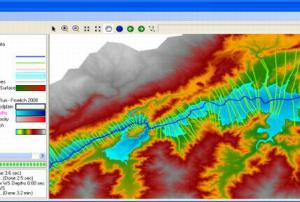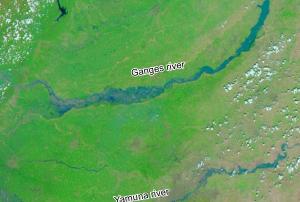Inundación
Definition
Facts and figures
Further information
UN-SPIDER Regional Support Offices with hazard-specific expertise
Related content on the Knowledge Portal
In June 2013, North India experienced heavy rainfall that triggered devastating floods and landslides in the states of Uttarakhand, Uttar Pradesh and Himachal Pradesh. The early monsoon rains causing the floods are believed to be the heaviest in 80 years. As of 24 June 2013, more than 600 people are confirmed dead while 80,000 have been rescued. BBC reported that thousands are still stranded in the holy pilgrimage site of Badrinath in higher Himalayan altitudes after flash floods hit the region last week.
UN-SPIDER's partner IWMI (International Water Management Institute) produced flood maps for Yamuna, Ghaghara and Ganga rivers and for the states of Uttarakhand and Uttara Pradesh using MODIS data from NASA Terra and Aqua satellites.
Further products are available on the...
read moreIn early June 2013, widespread flooding in central Europe has inundated swathes of Austria, Germany, Slovakia and the Czech Republic, killing at least 15 people.
Pre-Flood Soil Moisture:
Several providers have acquired and processed up to date satellite-derived maps of the affected areas:
Austria
read moreProvider Date Area Country Rapid Eye Various Various (Set search options accordingly) ... On 10 January 2013 the International Charter "Space and Major Disasters" was activated for floods in the Middle East to provide satellite imagery and derived maps. UN-SPIDER/UNOOSA requested the activation on behalf of UNOCHA, Pt Jerusalem Office. The National Space Organization (NSPO) already provided a Formosat2 image taken on 12 January 2013 over Palestine. The Imagery was processed by the FCU (Feng Chia University) GIS team.
After heavy rains, a deadly snow storm had hit parts of Israel, Palestine and Jordan causing power outages, structural and agricultural damage and loss of human lives. Since Thursday, 10 January, at least 4inches (10cm) of snow have fallen in Jordan. Thousands of people are living in refugee camps due to freezing weather conditions.
Reportedly, two fatalities occurred in Lebanon during a flash flood. At least 46 people have been injured in road accidents across Jordan. Several roads and schools have also been closed. Rescue efforts are...
read moreBetween September 17th and 19th 2010 heavy rains captured the area of Slovenia. A big part of the area of Slovenia was flooded. In the activation of the International Charter Space and Major Disasters the series of radar images was achieved. The paper presents the study of flood dynamics in the surroundings of the capital Ljubljana. Radar images enabled satisfactory near-real-time comprehension of flood dynamics, however not in urban areas. There were also some problems with high-grown plants (trees, crops). In these areas combinations with other data are going to be studied. Especially optical satellite images and digital elevation model (DEM) with its derivates (heights, slope, shadows) can improve the detection of floods in these parts of these areas. The short paper presents the results of flood detection produced by radar images. It also discusses the deficiencies of radar images for small water area detection. These deficiencies might be eliminated using...
read moreThis paper illustrates some applications of COSMOSkyMed (CSK) observations for rapid mapping of flooded areas and damages in small to medium size catchments. The results presented here have been obtained within the framework of the project “OPERA – Civil protection from floods” funded by the Italian Space Agency and run by a team of scientific research centres and private companies. The project aims to the systematic evaluation of the added value of the use of Earth Observation techniques into operational flood prediction chains. Due to the specific geomorphology of Italy, the focus is mainly on flash floods on small sized river catchments. Monitoring and modelling processes at proper space-time scales in this environment raise several issues to be solved, compared to applications in larger river basins. Here we address some related to the suitable use of CSK imagery.
read more






